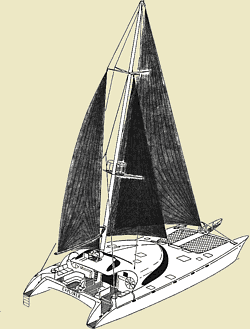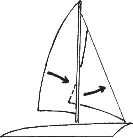
|
"Sail, the historic implement of world exploration, has within itself many new horizons that beckon for pursuit, but you have to be willing to venture past charted waters." - Gary Hoyt This quote from Gary Hoyt has never been more illuminating than today, when I introduce a new motorsailing design that sports 'another unusual sailing rig'. An inventive and resourceful gentleman, Tom Perkins, has 'ventured past charted waters' to bring us a modern version of the old square-rigger, the DynaRig. He has done it in a big way with a real-life 'proof-of-concept' aboard his innovative and fabulous new 290' superyacht, Maltese Falcon. My prior 'mast-aft ketch' had elicited notable resistance among members of the conservative sailing community, but I retain that discussion here on the website for those who can't grasp the newest concept of a free-standing, square-rigger. The DynaRig's application to a multihulled vessel is addressed under the new section, "DynaRig MotorSailer". The selling this new design and rig should be quite a bit easier following the prototyping provided by Maltese Falcon. Come
Soar With Us Into The Future
Revisiting
a Mast-Aft Sailing Rig Twenty five years ago, I was a younger fellow aspiring to become a sailing yacht designer. I was particularly interested in ocean going, cruising boats. I would devour every reference I could find on what made sailboats work. With keen interest I followed new developments on the racing circuits, believing that this was the incubator of fresh new ideas to speed our progress across the seas. Surely this breeding ground would bring significant evolution to the sport of sailing and the art of designing. "Au contraire", I became disillusioned so soon. Bruce King's fantastic twin, asymmetrical, bilgeboard development, disappeared in little over a year. Prof. Jerry Milgrams cat-ketches were afforded a similar welcome. Truely different sail rig innovations were totally discouraged, and numerous other design innovations were "rated" out of existence by handicap racing rules. Ocean going boats were not being designed to "mother-ocean's rules", but rather to some arbitrary, man-created, racer/cruiser rule. No thanks, let me look elsewhere. A group out of England, AYRS, Amateur Yacht Research Society came to my attention. A relatively new group of multihull enthusiast and their new publication, "Multihulls Magazine", also caught my attention. Here were some sources of true experimentation, innovation, and creativity; and subsequent evolution of the art of sailing, unbridled by handicap rules. Today, look at the French and their fantastic ocean racing boats both mono- and multi-hull; exciting innovation. Evolution; nature's onward march to better itself by slowly rejecting less efficient characteristics of the whole, and either replacing them with more efficient offspring, and/or redefining the whole as an entity. Change comes so sloooow in traditional sailing. Look how long it took the traditionalist to adopt the fully battened mainsail that multihulls have long been exploiting for the better part of 25 years. Did they just resist acknowledging it because it was foreign to them, or was it the handicap rules. I suspect both, but there is no doubt to its superiority; ah evolution! Now before you get too comfortable with this full-batten mainsail idea, realize that I do here intend to lay seize upon the sacred mainsail of the Bermudian rig. One
of the most influential books I had read was, "Sailing Theory
& Practice", by C.A. Marchaj. He subsequently published
another, "Aero-Hydrodyamics of Sailing". Both of these
books are the definitive technical source of what makes a sailboat
sail. And one other book, "The Art & Science of Sails",
by Tom Whidden and Michael Levitt, correctly describes the slot-effect
between the jib and main sails as explained comprehensively by the
aerodynamicist Arvel Gentry. In other words almost all the other
sailing books are wrong, and many of today's best sailors can
not describe correctly the aerodynamic interaction between
the headsail and the mainsail. The real driving force to develop an alternate rig was the many negative characteristics attributable to the mainsail:
Considering just those characteristics above, we really do have to call to question the use of a mainsail at all. No wonder the normal design practice when drafting a rig's C.E. (center of effort) evaluates the genoa at twice the effectiveness of the mainsail.
|
|||
|
|
|||
|
|
|||
|
|||
|
Now check out the CE's of the sails on the full-sail profile view. This rig maintains it's balance under a variety of sail combinations. Shorten sail initially by just rolling up the mainstaysail, and continue smartly under the genoa & mizzen combination. Wind really coming up, furl the genoa & mizzen and unfurl the mainstaysail. Not only is the sail area reduced significantly, the height of the CE is lowered substantially and correspondingly the overturning forces; and the rig is still in balance! Storm conditions arriving, zip the heavy-weight storm trysail on over the roller-furled mainstaysail. And all this could be accomplished without ever turning the boat into the wind!!
|
|||
|
|
|||
|
Gone is the heavy, low slung boom, as is the first aid on based heads. Gybing is less dangerous; and without sailtrack, jammed mainsail slides are gone. We can even reef our sail area without having to turn into the wind. All the halyards can be located in the cockpit as well as all the winching. And finally the most often asked question about this rig; how do you keep the leaning mast up? Well like any other mast, utilize creative, structural rigging. (Note: There are some rigging details omitted on the included drawings). The only time any other sailboat's mast is standing straight up, is at rest, at the dock. Otherwise it's always leaning over under sail. There are even numerous vessels which, at rest, had their mast raked back at a greater angle than mine is raked forward. Only recently as I began designing my 65' gamefishing cat did I re-evaluate the many virtues of this mast-aft rig. Once you hook a big fish you must get rid of all sail immediately, and this must be accomplished on any point of sail (no time to point up into the wind). This rig will do that. And if you're going to try and get a non-sailor to try fishing under sail, this thing better be real simple to operate. All three sails simply roll out and roll up. For fishing the mizzen's wishbone boom simply swings up out of harms way. Some of those virtues in summary:
In conclusion I want to note that I am not suggesting that this mast-aft configuration will or should replace the Bermudian rig, but rather that not all boats must have the pre-ordained Bermudian rig. There are, and should be alternatives. Garry Hoyt's stay-free, cat rigged, wishbone boomed, Freedom boats are a wonderful example of a relatively simple, efficient cruising rig. One should give serious consideration to the fundamentals of the ketch as an offshore cruising boat rig ,and with this in mind look at the similarities with my rig. Is not my rig an efficient evolution of the ketch concept? Oh, and lastly, I had to make sure that this rig did not appear so awkwardly different from traditional rigs that it would never attract converts. I think it's looks are acceptable? Brian
Eiland |
|||





